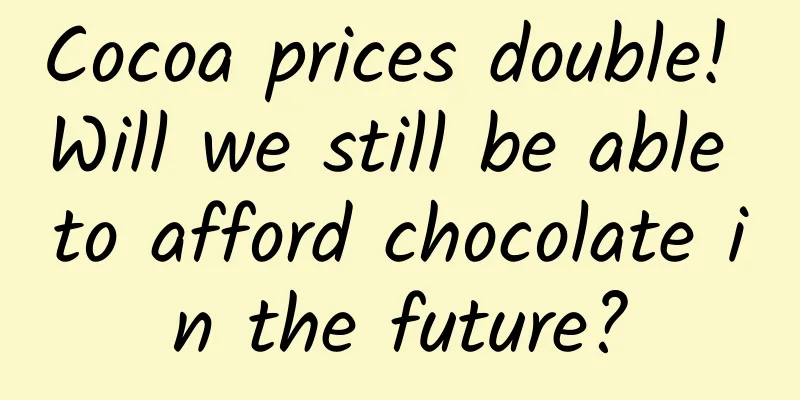Cocoa prices double! Will we still be able to afford chocolate in the future?

|
Recently, foreign netizens who love chocolate discovered that the chocolate has shrunk greatly?! Same price, different size. Nestle officials also admitted that it has indeed shrunk|jacquifelgate/ins Some chocolate companies, such as Hershey and Mondelez (the company that makes Oreos), have simply raised the price of chocolate . Other chocolate companies are trying to take sneaky "cost-cutting" measures - creating new recipes, reducing the amount of cocoa , and adding a higher proportion of fruits or nuts. The reason for these overt or covert chocolate price adjustments is that the price of cocoa, the raw material of chocolate, has been soaring in the past year . The price of cocoa was $4,275 per ton at the beginning of the year, and it rose to $9,481 in March, doubling directly; it even exceeded $10,000 per ton at one point, reaching a record high. This increase even exceeded that of Bitcoin. Why has the price of cocoa increased so much? Will we still be able to eat smooth chocolate in the future? Cocoa prices are rising rapidly , thanks to climate change About two-thirds of the world's cocoa is produced in West Africa, mostly in Côte d'Ivoire and Ghana. But extreme weather has caused a sharp drop in cocoa production in recent years, causing cocoa prices to soar. The cocoa tree has very high requirements for climatic conditions. It is afraid of flooding and likes to live in an environment with relatively high humidity . During the growth process, it is also necessary to pay attention to wind protection , because the leaves of the cocoa tree are large, and the leaves broken by strong winds are not conducive to photosynthesis. Unfortunately, weather conditions have not been very favorable in recent years. Rainfall, drought and strong winds in West Africa are more severe than usual , which is not conducive to the growth of cocoa. Flooded fields have also exacerbated the spread of black pod disease and swollen bud disease , which cause cocoa pods to rot and kill trees. According to the International Cocoa Organization (ICCO), the global cocoa supply will decrease by nearly 11% in the 2023/2024 season. Cocoa trees affected by swollen bud disease | REUTERS/Francis Kokoroko Low prices hurt farmers, but the soaring cocoa prices have not benefited farmers . In West Africa, most cocoa is produced by smallholders. The governments of Côte d'Ivoire and Ghana set prices before each new growing season , and these prices cannot keep up with the market, so smallholder growers have never profited from the soaring cocoa prices. They can only earn a contract of $1,600 for each ton of cocoa they sell, and this income does not increase because of the soaring cocoa prices on the market. Where does all that money go? In the cocoa sales chain, brokers find smallholder growers to buy cocoa from, then sell it to licensed purchasing managers, who then sell it to large commodity trading companies, which are then exported to chocolate manufacturers. The middlemen make a profit, while the farmers at the source get only a tiny profit. A trailer filled with cocoa beans that have been dried for generations. REUTERS/Francis Kokoroko This unequal distribution of benefits has actually exacerbated the current cocoa production decline. Among Ghana's 800,000 cocoa farmers, many survive on less than 15 yuan a day. Long-term low incomes have left farmers with no money to buy pesticides and fertilizers, no money to properly restore their fields, and no ability to withstand climate risks . This model itself is unsustainable. The growth of cocoa trees is very time-consuming, and it takes several years for them to produce cocoa beans stably. In the near future, if the climate remains bad, as the cocoa trees age, cocoa production will continue to decline, and it will be difficult for other growing countries to make up for the cocoa gap. The price of the chocolate we buy now may not increase significantly, but such waves will eventually hit consumers. Dark chocolate will be more affected, as it has a higher cocoa content, about 50% to 90% cocoa solids. Disappearing forests and monkeys lead to alarming carbon emissions The decline in cocoa production is due to climate change, but in turn, traditional cocoa cultivation itself sacrifices precious rainforests, indirectly contributing to the worsening of climate change. A study that measured carbon emissions between different foods was published in Science and is the largest meta-analysis of food systems to date. The data showed that chocolate is one of the foods with the highest carbon emissions , with each kilogram of chocolate equivalent to 19 kilograms of carbon dioxide. In this table, beef is far ahead in carbon emissions, with each kilogram of beef emitting 60 kilograms of carbon dioxide equivalent (CO2e). In addition, other foods with high carbon emissions include lamb, cheese and coffee. Chocolate’s carbon emissions mainly come from land use change, which can be seen as a long green strip | Our World in Data To measure the carbon emissions of a food supply chain, we mainly start from the following aspects: Land use change Farming/breeding Animal Feed Processing transportation retail Package Chocolate's carbon emissions mainly come from changes in land use . When more trees are planted or wetlands are restored, plants can capture carbon dioxide through photosynthesis, thereby increasing carbon sinks; while deforestation weakens the land's ability to absorb carbon dioxide. As the demand for cocoa continues to grow, more and more rainforests are being cut down to plant cocoa . When forests are cut down or burned, they release stored carbon; newly planted cocoa trees are often not as carbon-fixing as natural rainforests , and can absorb less carbon dioxide; during the planting process, the soil often needs to be disturbed, which also releases carbon stored in the soil. In short, turning rainforest into cocoa trees is not only accompanied by a series of carbon emissions, but also reduces the ability of the area to absorb carbon. Cutting down trees to grow cocoa|Ruth Maclean/The Guardian The loss of rainforests has more direct consequences. Tropical rainforests have the highest biodiversity on Earth, and areas suitable for cocoa cultivation are the places with the most species of organisms in the world . Deforestation means the disappearance of many biological habitats, and the losses caused by the destruction of the ecosystem are difficult to measure. In order to investigate endangered primates in West Africa, researchers from Ohio University visited 23 forest reserves in West Africa from 2010 to 2013 and found that at least 20 of the reserves had been illegally deforestationed, 13 of which had lost all their primate populations, and the remaining populations had also been reduced by more than half. 74% of the original primeval forests have become "no forests, no monkeys, just a sea of cocoa trees" . The ecosystem formed by this monoculture is also very fragile and even more difficult to resist pests and diseases and climate change. More sustainable chocolate? Fortunately, cocoa and forests are not in a life-and-death relationship. Cocoa does not like direct sunlight, so monoculture is not suitable for it. Instead, cocoa grows better when planted with trees that can provide shade . The study shows that when there are different shade tree species in artificial planting systems, cocoa plantations can support higher levels of biodiversity than most other tropical cash crops, becoming a shelter for many tropical organisms . At the same time, these organisms can help cocoa reduce the invasion of pests and diseases and resist climate risks. There are already brands investing specifically in shade-grown cocoa , such as Green & Black's (owned by Mondelez). In addition to focusing on planting methods, some organizations start with fairer trade, which can enable small farmers on the production side to obtain better returns , which is not only conducive to alleviating local poverty, but also enables farmers to produce cocoa in a more sustainable way. The Rainforest Alliance Certification Project is doing just that, aiming to get farmers to use better farming methods, protect the environment while adapting to climate change, and generate higher incomes. The Rainforest Alliance Certification started with coffee and later expanded to cocoa and hazelnuts. The Rainforest Alliance certification logo is a frog. Friends who often drink coffee may recognize it|rainforest-alliance.org There are also some brands directly owned by small farmers , such as Divine, a chocolate supplier founded in the UK, which is jointly owned by the Kuapa Kokoo cocoa farmers' cooperative in Ghana and other companies that support fair trade, so that the net profit of the company belongs to the farmers and the middlemen earn the difference. These sustainable production methods seem far away from us, but from the moment we take a bite of chocolate, we are already connected to the complex climate change and cocoa farmers thousands of miles away. Some people may ask, is it really useful to care about these things? Attention itself is scarce, and every bit of attention may promote more sustainable attempts. I hope that people in the future can also taste the wonderful taste of chocolate. Author: Yellow pollock Editor: Mai Mai |
Recommend
Ten thousand words long article: Hand in hand teaching you how to play with private domain traffic
There are many articles discussing the concept of...
[Creative Cultivation Program] How to tame the "hot-tempered" lithium battery?
Lithium batteries can be said to be a major proje...
Can Dong Mingzhu's Gree washing machine break the Gree mobile phone curse?
Just as the hype about Gree mobile phones died do...
Domestic cars can also be so cool. Roewe i6 opens a new chapter of intelligent interconnection
At the 2016 Guangzhou Auto Show, SAIC Roewe relea...
Looking back at 10 years of LCD TVs: How did they kill plasma?
For those born in the 1980s and even the 1990s, t...
Oil lives in a nanoscale "bedroom"? Let's take a look at the "close-up" of shale magnified a million times
The Daqing Oilfield core library is filled with n...
The "flight mode" of mobile phones has not been cancelled. Insiders tell you the answer. Hope you know it
The development of the Internet era has brought m...
Clams, mussels, cockles, and cockles... Do you know all the shells in the vegetable market?
Audit expert: Li Weiyang Well-known science write...
The latest news on the four-child policy in 2022: What are the specific subsidy policies? Can medical insurance be reimbursed?
Since the full implementation of the three-child ...
Manual for identifying “high-quality imitation” edible fungi | Do you know about these high-risk “health foods”?
From the New Year's Eve dinner to the reunion...
Grasp 20 human weaknesses and you will be an operation master
What weakness marketing does is to lead people to...
Mango TV starts Kung Fu mode: "But we are not all-powerful heroes"
The number of users has exceeded 10 million, the ...
Can subscription pricing bring Windows back to life?
Microsoft has just registered the "Windows 3...
After chatting with a group of marketing directors, some understandings about leading a team
After working for three to five years, most of my...
Brand Communication Plan for 2022
It’s the end of the year, and it’s time for brand...









